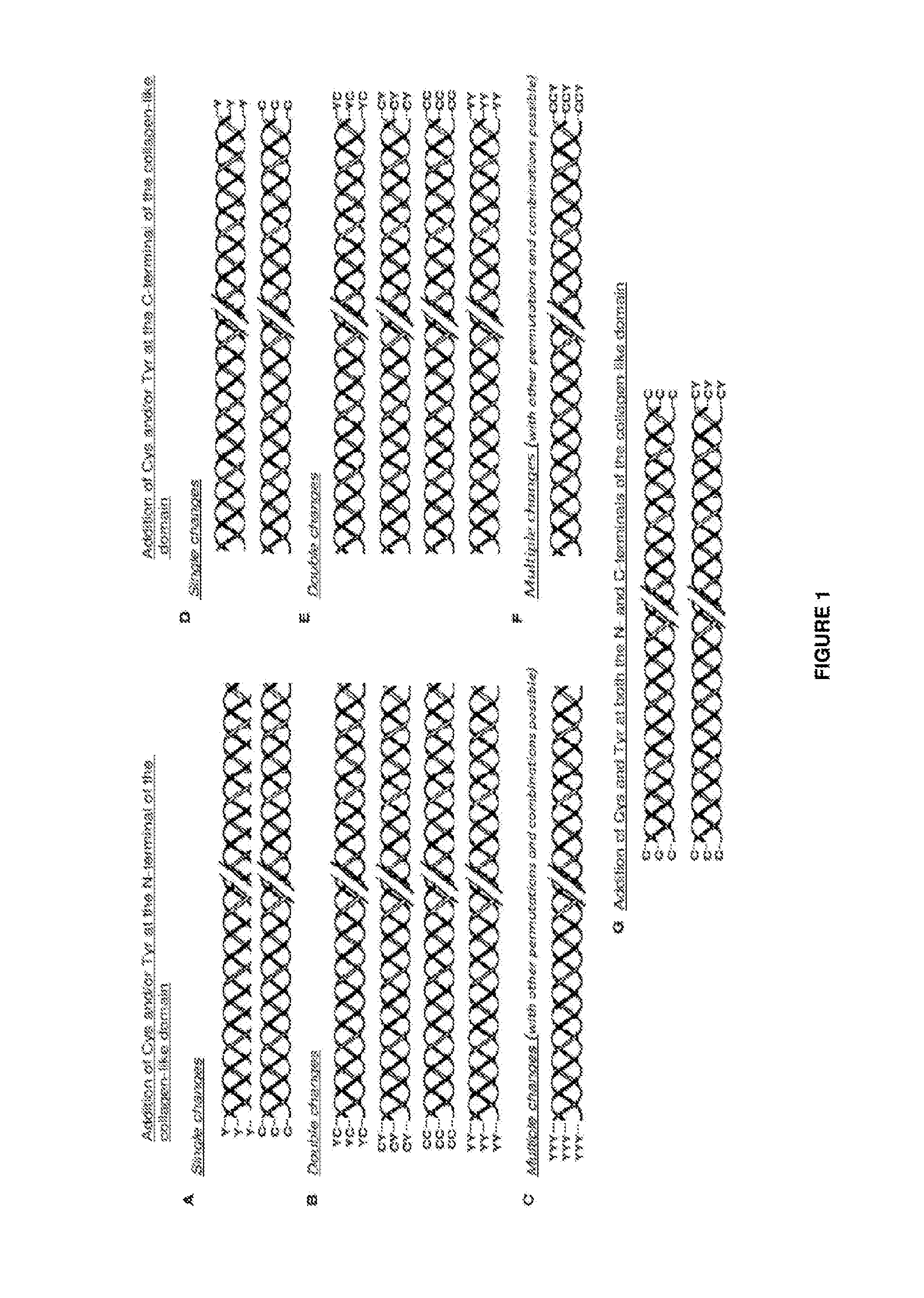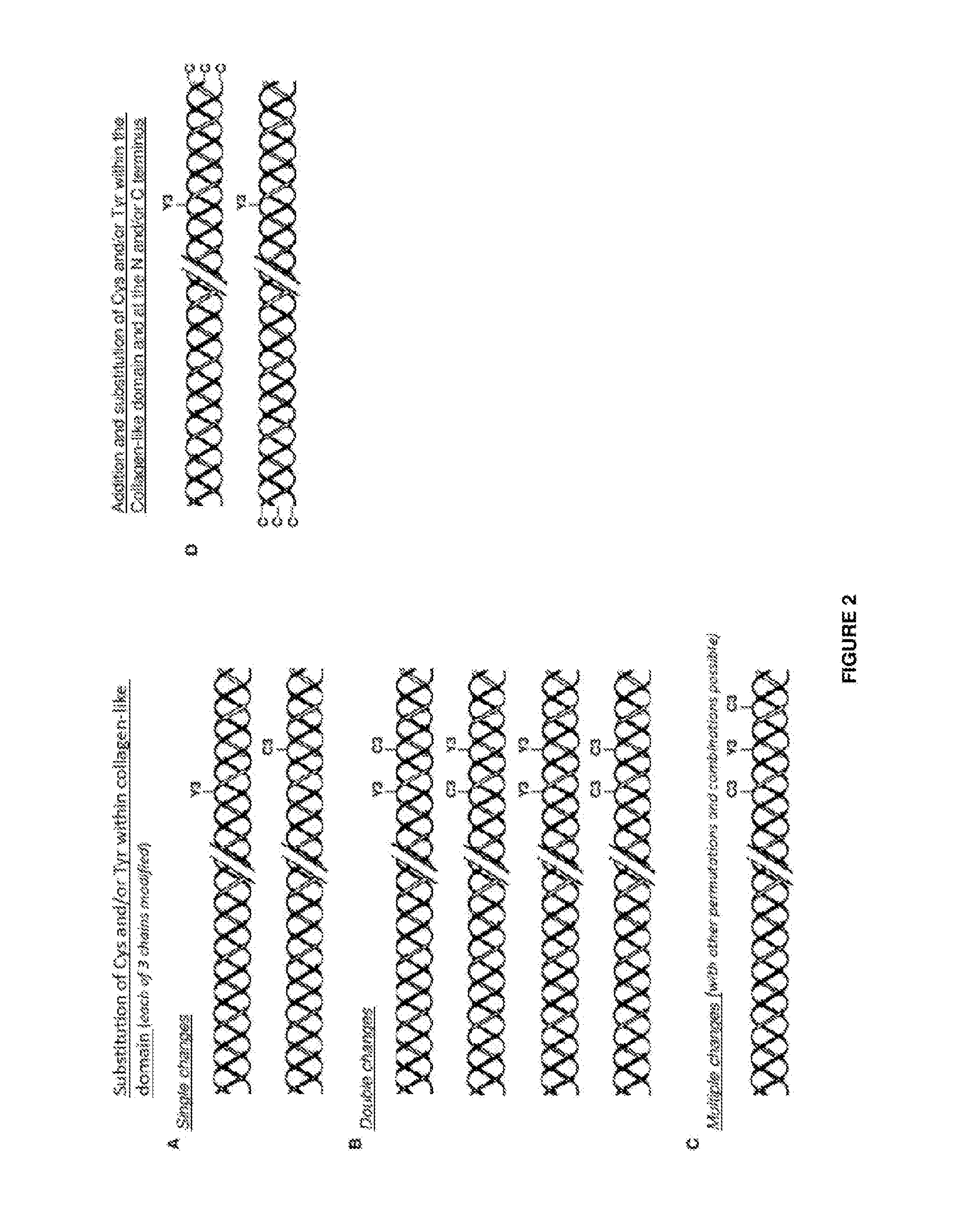Modified bacterial collagen-like proteins
a technology of collagen-like proteins and modified bacterial collagens, which is applied in the direction of bacteria peptides, peptide sources, peptide/protein ingredients, etc., can solve the problems of complex yeast systems, limited animal-derived collagens, and inability to design and modify extracted collagens to enhance or change specific biological or functional properties, etc., to facilitate cross-linking of recombinant collagen-like proteins, improve the properties of proteins, and easy to oxidise
- Summary
- Abstract
- Description
- Claims
- Application Information
AI Technical Summary
Benefits of technology
Problems solved by technology
Method used
Image
Examples
example 1
A Bacterial Collagen Sequence with an Introduced Tyr Residue at the C-Terminal
[0159]The DNA sequence for the fragment of the scl2.28 allele (Q8RLX7) encoding the combined globular and collagen-like portions of the Scl2.28 protein, but lacking the C-terminal attachment domain, was obtained from the data provided in the National Center for Biotechnology Information database (National institutes of Health, Bethesda, Md. 20894, USA) as record GenBank: AY069936.1). To this sequence a His6 tag was introduced at the N-terminal and a thrombin / trypsin cleavage sequence LVPRGSP (SEQ ID NO: 1) was inserted between the N-terminal globular domain (V) and the following (Gly-Xaa-Yaa)n triple-helical / collagen-like (CL) domain sequence. A triplet sequence GKY was included at the C terminal of the CL domain, followed by a stop codon, with NdeI and BamHI cloning sites. The DNA for this design was synthesised commercially without any codon optimisation. SEQ ID NO: 2 is the final DNA construct. SEQ ID N...
example 2
A Bacterial Collagen Sequence with an Introduced Cys Residue at the N-Terminal
[0160]The DNA sequence for the triple helix repeat-containing collagen from Candidatus Solibacter usitatus Ellin6076 is obtained from the data provided in the National Center for Biotechnology Information database (National institutes of Health, Bethesda, Md. 20894, USA) as record ABJ82342. The DNA sequence for the V-domain from Rhodopseudomonas palustris was obtained from the data provided in the National Center for Biotechnology Information database (National institutes of Health, Bethesda, Md. 20894, USA) as YP_001993084. The protein sequences are translated into nominal DNA sequences and a composite gene designed that maintains the correct coding framework, with a Met initiation signal followed by an extra amino acid sequence that contained a Cys residue, Gly-Cys-Pro, then the CL domain from S. usitatus, then the V-domain from R. palustris, followed finally by a C-terminal His6-tag and a termination co...
example 3
A Bacterial Collagen Sequence with Introduced Cys and Tyr Residues Both at the C Terminal
[0161]The sequence of this example was prepared as described in Example 1, except that the sequence at the C-terminal of the protein, at the end of the CL-domain was Gly-Tyr-Cys, followed by a stop codon and restriction sites, with the DNA for this sequence synthesised commercially without any codon optimisation. The sequence of this construct is shown in SEQ ID NOs:6 and 7.
PUM
 Login to View More
Login to View More Abstract
Description
Claims
Application Information
 Login to View More
Login to View More - R&D
- Intellectual Property
- Life Sciences
- Materials
- Tech Scout
- Unparalleled Data Quality
- Higher Quality Content
- 60% Fewer Hallucinations
Browse by: Latest US Patents, China's latest patents, Technical Efficacy Thesaurus, Application Domain, Technology Topic, Popular Technical Reports.
© 2025 PatSnap. All rights reserved.Legal|Privacy policy|Modern Slavery Act Transparency Statement|Sitemap|About US| Contact US: help@patsnap.com



